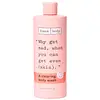What's inside
What's inside
 Key Ingredients
Key Ingredients

 Benefits
Benefits

 Concerns
Concerns

 Ingredients Side-by-side
Ingredients Side-by-side

Water
Skin ConditioningSodium Lauroyl Sarcosinate
CleansingLauryl Glucoside
CleansingHydroxyethylcellulose
Emulsion StabilisingCitrus Aurantium Dulcis Peel Oil
MaskingCitrus Paradisi Peel Oil
MaskingPelargonium Graveolens Flower Oil
MaskingCitrus Aurantifolia Oil
CleansingRosa Damascena Flower Oil
MaskingPogostemon Cablin Leaf Oil
MaskingCananga Odorata Flower Oil
MaskingSimmondsia Chinensis Seed Oil
EmollientRosa Canina Fruit Oil
EmollientMelaleuca Alternifolia Leaf Oil
AntioxidantMacadamia Integrifolia Seed Oil
Skin ConditioningAlcohol
AntimicrobialXanthan Gum
EmulsifyingChamomilla Recutita Flower Extract
MaskingPolysorbate 60
EmulsifyingDisodium Phosphate
BufferingSodium Phosphate
BufferingLimonene
PerfumingCitronellol
PerfumingCitric Acid
BufferingPhenoxyethanol
PreservativeBenzyl Alcohol
PerfumingPotassium Sorbate
PreservativeLinalool
PerfumingGeraniol
PerfumingWater, Sodium Lauroyl Sarcosinate, Lauryl Glucoside, Hydroxyethylcellulose, Citrus Aurantium Dulcis Peel Oil, Citrus Paradisi Peel Oil, Pelargonium Graveolens Flower Oil, Citrus Aurantifolia Oil, Rosa Damascena Flower Oil, Pogostemon Cablin Leaf Oil, Cananga Odorata Flower Oil, Simmondsia Chinensis Seed Oil, Rosa Canina Fruit Oil, Melaleuca Alternifolia Leaf Oil, Macadamia Integrifolia Seed Oil, Alcohol, Xanthan Gum, Chamomilla Recutita Flower Extract, Polysorbate 60, Disodium Phosphate, Sodium Phosphate, Limonene, Citronellol, Citric Acid, Phenoxyethanol, Benzyl Alcohol, Potassium Sorbate, Linalool, Geraniol
Water
Skin ConditioningCocamidopropyl Betaine
CleansingAloe Barbadensis Leaf Extract
EmollientMyristamide Dipa
CleansingSodium Lauroyl Sarcosinate
CleansingSalicylic Acid
MaskingCoffea Robusta Seed Extract
Skin ConditioningPunica Granatum Fruit Extract
AntioxidantTerminalia Ferdinandiana Fruit Extract
AntioxidantParfum
MaskingDecyl Glucoside
CleansingPanthenol
Skin ConditioningGlycerin
HumectantSodium Cocoamphoacetate
CleansingSodium Cocoyl Glutamate
CleansingAcrylates/C10-30 Alkyl Acrylate Crosspolymer
Emulsion StabilisingPotassium Sorbate
PreservativePhenoxyethanol
PreservativeTriethanolamine
BufferingWater, Cocamidopropyl Betaine, Aloe Barbadensis Leaf Extract, Myristamide Dipa, Sodium Lauroyl Sarcosinate, Salicylic Acid, Coffea Robusta Seed Extract, Punica Granatum Fruit Extract, Terminalia Ferdinandiana Fruit Extract, Parfum, Decyl Glucoside, Panthenol, Glycerin, Sodium Cocoamphoacetate, Sodium Cocoyl Glutamate, Acrylates/C10-30 Alkyl Acrylate Crosspolymer, Potassium Sorbate, Phenoxyethanol, Triethanolamine
Ingredients Explained
These ingredients are found in both products.
Ingredients higher up in an ingredient list are typically present in a larger amount.
Phenoxyethanol is a preservative that has germicide, antimicrobial, and aromatic properties. Studies show that phenoxyethanol can prevent microbial growth. By itself, it has a scent that is similar to that of a rose.
It's often used in formulations along with Caprylyl Glycol to preserve the shelf life of products.
Potassium Sorbate is a preservative used to prevent yeast and mold in products. It is commonly found in both cosmetic and food products.
This ingredient comes from potassium salt derived from sorbic acid. Sorbic acid is a natural antibiotic and effective against fungus.
Both potassium sorbate and sorbic acid can be found in baked goods, cheeses, dried meats, dried fruit, ice cream, pickles, wine, yogurt, and more.
You'll often find this ingredient used with other preservatives.
Learn more about Potassium SorbateSodium Lauroyl Sarcosinate is a cleansing agent and emulsifier. It is a surfactant derived from sarcosine, and a common source is coconut oil.
As a surfactant, Sodium Lauroyl Sarcosinate helps lift dirts, oil, and other molecules to be washed away. In leave-on products, this ingredient is used as an emulsifier. Emulsifier help prevent ingredients such as oils and waters from separating.
Sodium Lauroyl Sarcosinate is also commonly found as a foaming agent in shampoo, toothpaste, and shaving foam. It is amphiphilic, meaning it loves both water and fats.
Learn more about Sodium Lauroyl SarcosinateWater. It's the most common cosmetic ingredient of all. You'll usually see it at the top of ingredient lists, meaning that it makes up the largest part of the product.
So why is it so popular? Water most often acts as a solvent - this means that it helps dissolve other ingredients into the formulation.
You'll also recognize water as that liquid we all need to stay alive. If you see this, drink a glass of water. Stay hydrated!
Learn more about Water